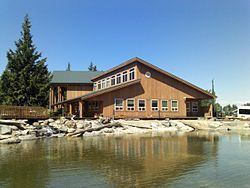Country United States Elevation 207 ft (63.0936 m) | Negotiated December 26, 1854 Time zone Pacific (PST) (UTC-8) | |
 | ||
Squaxin island tribe coho survival study
The Squaxin Island Tribe (also Squaxin, Squaxon) is a Native American tribal government in western Washington state in the United States. The Squaxin Island Tribe is made up of several Lushootseed clans living along several inlets of southern Puget Sound:
Contents
- Squaxin island tribe coho survival study
- hawk squaxin island tribe native american artists
- Squaxin Island Indian ReservationEdit
- Little Creek Casino ResortEdit
- MuseumEdit
- Paddle to Squaxin Island 2012Edit
- PoliceEdit
- References
Because of their strong cultural connection with the water, they are also known as the People of the Water. The modern tribe is named after the Squawksin of Case Inlet - meaning “in between” or “piece of land to cross over to another bay” in the Lushootseed language; the name was changed to Squaxin Island.
The Squaxin Island people speak the Lushootseed language. They moved onto their reservation in modern-day Mason County, Washington, in 1855. The Squaxin Island Tribe was one of the first Native American tribes in the U.S. to enter into the Self Governance Demonstration Project with the federal government.
hawk squaxin island tribe native american artists
Squaxin Island Indian ReservationEdit
The Squaxin Island Indian Reservation is in southeastern Mason County, Washington. Most of the main reservation is composed of Squaxin Island, but there is also a small part of 26.13 acres (105,700 m2) at Kamilche, in addition to two parcels of off-reservation trust land near Kamilche, as well as a plot of 6.03 acres (24,400 m2) across Pickering Passage from Squaxin Island and a plot of 35.93 acres (145,400 m2) on Harstine Island, across Peale Passage. The total land area including off-reservation trust lands is 6.942 km² (2.68 sq mi, or 1,715.46 acres). Of the total resident population of 405 persons (2000 census), 383 lived in off-reservation trust land to the southeast of Kamilche, and 22 lived on Harstine Island, while the bulk of the reservation's territory, Squaxin Island, was unpopulated.
Little Creek Casino ResortEdit
Little Creek Casino Resort at Kamilche is owned and operated by the Squaxin Island Tribe. LCCR is a Northwest Native American themed Resort.
MuseumEdit
Squaxin Island Tribe had a Squaxin Island Museum, Library and Research Center as early as 2007. The Squaxin Island Museum Library and Research Center was built circa 2002. The 13,000-square-foot (1,200 m2) building, designed by a Seattle architecture firm, is shaped to resemble Thunderbird in profile.
Paddle to Squaxin Island 2012Edit
The Tribal Journeys began in 1989, intending to coincide with the centennial celebration for Washington State. A total of 9 canoes participated in the "Paddle to Seattle" journey, and in 1993, 23 canoes participated in the "Paddle to Bella Bella". Since 1993, "Tribal Journeys" or "The Paddle" has been held annually, with various tribes serving as the host tribe. A total of 102 canoes landed for the "Paddle to Squaxin Island" journey.
An estimated 40,000 people attended or visited the "Paddle to Squaxin Island" journey, hosted by the Squaxin Museum and The Evergreen State College, and funded by a National Endowment for the Arts "Our Town" grant. Protocol and Dining were held in an old baseball field. The quiet community was loud for a whole week. Months before the event, major construction was done. Many parking lots were made, a campground was built and a Reflecting Pond was put in the Tribal Government Campus.
Tribes from around the country and world attended the event, such as New Zealand, Canada, Alaska, etc.
PoliceEdit
The Squaxin Police Department, or "Squaxin P.D." is a small tribal police enforcement that usually only stays on the reservation and Little Creek Casino Resort at Kamilche. From the 1970s to 2005, the Squaxin police station, tribal center, gym, research center and education center used to share the same building in what is currently the wellness center (gym and pool). The "Squaxin Drug Task Force" is also enforced by Squaxin P.D.
